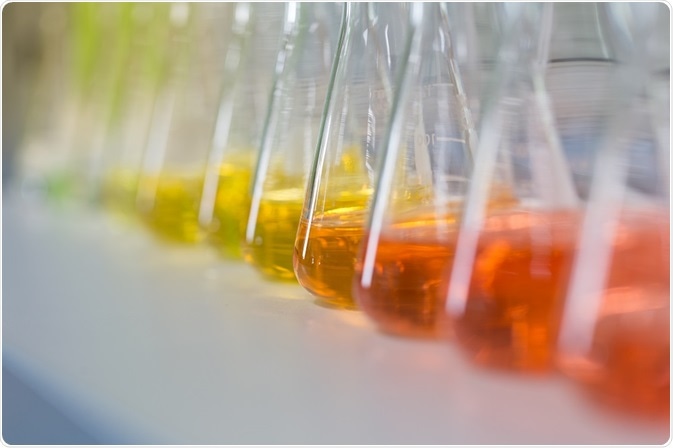Karl Fischer (KF) titration is a widely used technique for moisture or water determination in solid, liquid and gaseous samples. It has a host of applications in industrial quality control.
 Image Credit: Rattiya Thongdumhyu / Shutterstock
Image Credit: Rattiya Thongdumhyu / Shutterstock
Principles of Karl Fischer titration
The KF reaction is based upon the oxidation of sulfur dioxide by iodine with the consumption of water in a buffered solution:
I2 + 2H2O + SO2 -> 2HI + H2SO4
The titration reaches its endpoint when the titrating agent has achieved a volume sufficient to react the total amount of water in the sample. Water and iodine are used up in an equimolar ratio.
The color change that signals the end point of the reaction is caused by the detection of excess iodine at the double platinum electrode which acts as the indicator, following the consumption of all the water in the sample which leads to the cessation of the reaction. The water content is then calculated from the amount of reagent added.
The titration cell must be kept from atmospheric moisture and the sample must not react with the KF reagent. For instance, ketones and aldehydes must be titrated in methanol-free solvents because otherwise they react with methanol, forming water, which results in a falsely high water concentration and a vanishing end point.
The reaction is sensitive to pH and therefore a buffer must be used if strongly acidic or basic samples are to be titrated.
Alcohol (methanol, ethanol or a propylene-glycol mixture) is the solvent usually used both for the sample and in the titration cell. When the iodine is in excess the reaction has reached its end point. The most advanced KF titration technology uses a double platinum electrode for electrochemical indication of the end point, but visual and photometric indicators are also used.
Methodology
There are two primary methods of KF titration, namely volumetric and coulometric. KF titration is very fast and specific, determining only water in both free and bound forms. Special KF titrators are available as well as ready-to-use KF reagents.
A third method is now used, the Hybrid Karl Fischer titration. This is more flexible and advanced than the other two, and combines them by using coulometric titration primarily, but adding a solution containing a preset amount of iodine simultaneously if the water content is above a defined limit requiring volumetric titration.
History
The KF titration was first devised by the German chemist, Karl Fischer, to find the water content of liquid sulfur dioxide. Since other commonly-used methods were not suitable, he used the Bunsen reaction shown below.
SO2 + I2 + 2H2O <-> H2SO4 + 2HI (1)
He used a new reagent including sulfur dioxide, iodine and pyridine, in a methanol solution, giving rise to the following equation:
SO2 + I2 + 2H2O*Py <-> H2SO4 + 2HI (2)
At end point the color changed from yellow to brown. Thus he performed the first volumetric KF titration. This was refined by American researchers later in 1939 and the two steps were modified by changing the molar ratio of water to iodine:
H2O + SO2*Py + Py*I2
+ Py + MeOH <-> 2HI*Py + Py*SO3 (3a)
Py*SO3 + MeOH <-> Py*MeSO3H (3b)
The final version came in 1984 when it was known that pyridine was not part of the reactants, but only a base (represented as B):
SO2 + HO-R + B <-> R-SO3- + BH+ (4a)
R-SO3- + I2 + H2O + 2B <-> R-SO4- + 2I- + 2BH+ (4b)
The reaction converts the reagent into an alkyl sulfite which is then oxidized by the iodine, if water is present. The alcohol is essential for proper stoichiometric ratios to be preserved, at about 50%, but other bases can be used instead of the pyridine – which is important because of its pungent smell and toxicity which has led to its replacement by non-toxic imidazole and other bases.
This has another advantage, in that these are generally more basic and so increase the rate of the reaction leading to a quicker reaction and increased stability of the end point.
Sample preparation
The samples must be prepared differently depending on their state. Solids have bound water either adsorbed or held as water of crystallization, or trapped in the molecule. Therefore they must be completely dissolved in a suitable solvent. The solid should be powdered to aid dissolution. External extraction is sometimes practiced.
Liquids are injected into the titration cell through a septum, without disturbing the water-free condition. Gases are best titrated by coulometric KF titration because of the typically minute water content.
Insoluble or very reactive samples are suited for the KF oven method where the water is driven off by evaporation into a titration chamber for reaction with the KF reagent.
Applications of Karl Fischer titration
The water content in a large array of materials can be determined using KF titration. These include foodstuffs, chemical reagents, pharmaceuticals and plastics. The amount of water titrated may range from one ppm to 100% water. This includes both surface water and that bound within crystals.
Further Reading